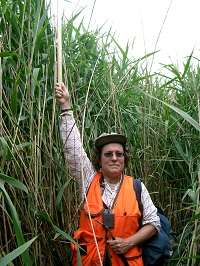Scientist documents wetland losses

(Phys.org) —Wetlands in eastern North and South Dakota are shrinking at a rapid pace, according to professor Carol Johnston of the South Dakota State University Natural Resource Management Department.
The wetlands and soil science expert compared Department of Agriculture crop maps with wetland maps from the U.S. Fish and Wildlife Service and the U.S. Geological Survey. She identified those areas that were once wetlands but are now cropland to determine the amount of loss and verified her findings using aerial photos.
The study focused on the Prairie Pothole Region in the eastern Dakotas, Johnston explained. "That's where most of the wetlands and croplands are." Her article was published in Wetlands, the Journal of the Society of Wetland Scientists. The Prairie Pothole region extends from Iowa through the Dakotas into Canada and provides habitat for more than 50 percent of North American migratory waterfowl.
She compared wetlands maps from the 1980s and 2001 to cropland maps from 2011. If the area on the earlier wetlands maps was identified as cropland in 2011, Johnston explained, "it was no longer a wetland."
Comparing wetlands mapped 30 years ago with those areas in 2011, she documented a yearly loss of nearly 13,000 acres of wetlands. Considering only the changes in the last decade, those losses increased to 15,377 acres per year.
The 2012 data came out this spring and, Johnston said, "the rate just keeps going up."
These changes in land use affect not only wildlife but human beings. "Wetlands provide many ecosystem services," Johnston explained. Wetlands improve water quality downstream by trapping sediment and filtering out pollutants such as phosphorus.
"Wetlands are called the kidneys of the landscape," Johnston said. The soil microbes in wetlands convert nitrate, a form of nitrogen dissolved in the water, into harmless nitrogen gas. Nitrates can pollute well water, making it unfit to drink. Without the filtering effects of wetlands, these nitrates can also encourage the growth of algae. When these algae decompose, they decrease the oxygen available for fish and other aquatic organisms.
Wetlands help recharge groundwater supplies in many places, Johnston explained. Because these shallow reservoirs hold excess water, they can also reduce flooding downstream. Johnston cited an instance in which wetlands along the Charles River in Massachusetts were bought and maintained specifically for the purpose of reducing floods in the city of Boston.
Near Hillsboro, N.D., a 160-acre area that was once a shallow pond is now completely cropland, Johnston explained. "Many wetlands dry up naturally during droughts like we had last year, but I did my study at the end of a three-year wet period, so I'm sure the wetland loss was not due to drought."
The combination of higher commodity prices and a drop in the number of acres enrolled in the Conservation Reservation Program, known as CRP, have contributed to the conversion of wetlands into croplands. This program pays landowners to set aside land as wetlands and grasslands.
"Many acres are going off of CRP in both the Dakotas," Johnston said. Contracts on 105,387 acres of land in South Dakota and 253,746 acres in North Dakota are set to expire in September, and U.S. Department of Agriculture officials expect that many of these acres will be converted to cropland.
Johnston explained that wetland losses in the Dakotas affect a much larger area.
"Loss of nutrients as a result of wetland drainage can increase the amount of nitrogen going downstream," she explained. "What we do in South Dakota impacts people all the way down to the Gulf of Mexico."
Provided by South Dakota State University

















